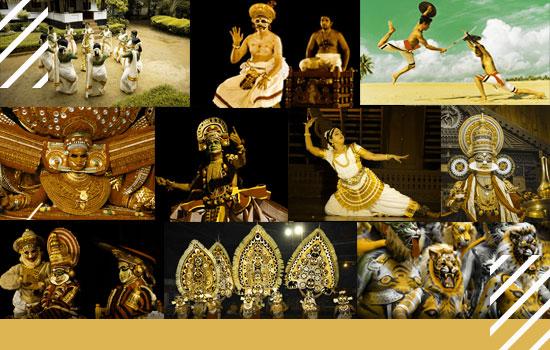It feels amazing to walk into a store and watch the craftsmen working with gleaming gold threads, peering over a rickety hand-loom using age old techniques.
Kashi is famous for Brocade Weaving Centre with extravagant cultural, religious, and historical significance.
The know-how of this weaving tradition has been passed on to them while they were kids from their forefathers.
These sarees are loved and appreciated by all women and they are not only famous in the Indian fashion industry but also in the global fashion market.
Recommended Story – A-Z List of Traditional Sarees from states of India
A Walk through the Past

Although these sarees date back to the Hindu mythology of Ramayana in the 1000 to 300 B.C., there have been several words regarding its history.
Mughal Empire is known to have introduced ‘Banarasi Silk’ with its intricate weaving and designing craftsmanship and today, these sarees are a mix of Mughal and Indian cultures.
The use of motifs like Buttis, Paisley, Jhallar, Bel, and Shikargah (hunting) can be frequently seen here.
At the same time, the British records state that the ancient city of Varanasi was always a significant weaving center and the products were also exported to Europe.
Making or Weaving Process of Banarasi Sarees
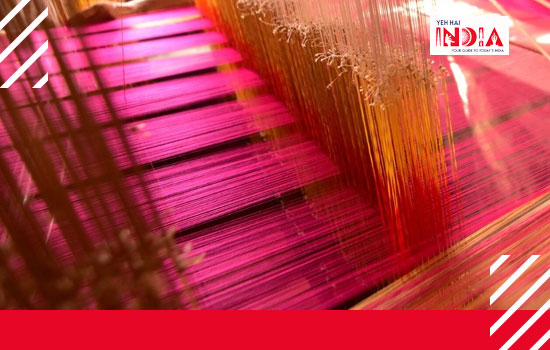
The time taken in the making of a Banarasi saree depends on the complexity of the designs.
The process requires proper teamwork with a minimum of 3 weavers.
One weaves the main part of the saree, second handles the revolving ring to make bundles, and the third assists in border designing.
An ideal Banarasi saree has around 45 inches width with 5600 thread wires for which a base of 24-26 inches long is made.
A design board is created by sketching designs on graph paper and deciding the color concepts.
The loom to weaving the saree is set up accordingly and the threads are assembled.
Authentic pieces use the purest forms of Zari, Metallic Yarns, made of copper yarns with gold and silver polish used for the creation of border and motifs on the saree.
As soon as the graph is ready and the design is decided, the weaving starts, which may take a few days to few months.
After the motifs are weaved, the saree can be dyed in a variety of colors, as pleased.
Fabric Varieties of Banarasi Sarees
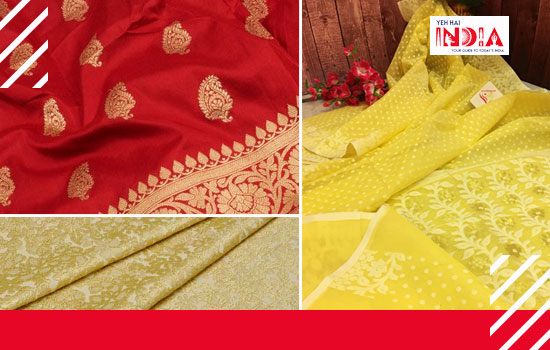
Banarasi sarees have been classified into four distinct varieties – namely Pure Silk (Katan), Organza (Kora) with zari and silk, Georgette and Shattir, out of which pure silk is the most renowned.
On the basis of designs, they are called Jangla, Tanchoi, Vaskat, Cutwork, Tissue, Butidar and most essentially, Banarasi Silk Jamdani.
- In Jamdani sarees, silk fabric is brocaded with cotton.
- Jangla are designed with colorful silk threads to show the nature and heaviness of festivity with widely spread and scrolled designs.
- Tanchoi uses extra weft silk yarn for the border.
- Tissue Sarees are a combination of zari and silk.
- Cutwork is a technique of cutting done on plain textures after removing floated threads.
- Butidar are dark blue silk sarees brocaded with silver and gold threads.
Brocades
Brocades are a stunning example of human skills and creativity.
These are particularly shuttle woven and have embossed or raised effect by using Zari yarns (metallic yarns).
The fabric with heavy brocading using over 60-65% of zari is called ‘Kimkhab’.
These are found in two categories:
- Kadhua Banarasi Brocade is discontinuous brocade where each motif is woven individually. This is an extremely tedious and time intensive technique.
- Fekuan Banarasi Brocade is continuous brocade where the motifs run from end to end.
Color and Motifs
Banarasi sarees can be found in a variety of colors, so there is no specific color board catering to them.
These are majorly known for the gold or silver zari work that adorns them.
The motif designs majorly consisted of Islamic motifs such as floral patterns, styled leaves, and jail work (net), inspired from the architecture of the Mughal era.
Eventually, geometric patterns along with the Hindu Gods figurines came in.
Recommended Story – Saree- The Indian Dress
Current State of the Art
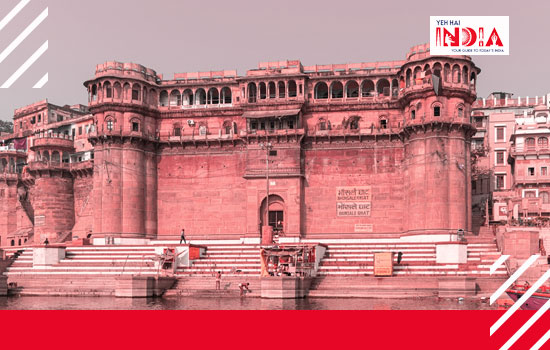
These sarees have been facing a strong competition from the machine made factories that produce sarees at a faster speed and a cheaper price.
Though, the authenticity of a handmade Banarasi saree never goes away.
The saree takes time and effort to be made and comes with a hefty price tag.
People are still willing to buy it knowing the value is worth due to the beauty and originality of the masterpiece.
Also, in 2009, the Uttar Pradesh Weavers Association secured a copyright of all sorts of Banarasi brocade and sarees, according to which, sarees or brocades coming out from different districts that use anything other than the traditional methods will not be sold under the name of Banarasi sarees and silk.
Where to Buy
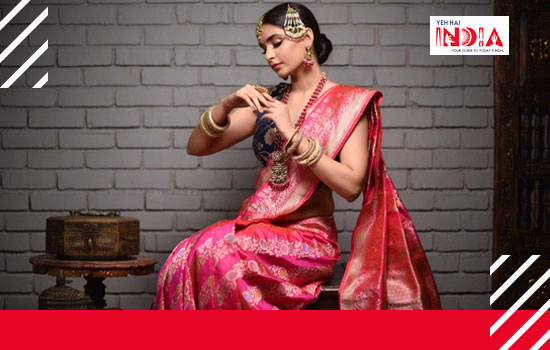
You can buy these sarees while visiting Banaras, or if not that, you can get them online.
There are numerous fashion brands like Ekaya Banaras, Tilfi, Raw Mango, House of Raisons etc. working on Banarasi sarees.
Conclusion
India is one of the top most producers of silk and exports it all over the world, Banarasi silk being a part of it.
The traditional Banarasi Silk Saree is famous all around the globe due to unique patterns and intricate designs and for the originality and celebration of the craft depicted by it.
Bollywood celebrities and popular personalities are now donning Banarasi Sarees for various occasions.
It truly makes to the list of must-haves in the wardrobe.
Also Read – Raw Mango: Beauty lies in imperfections!





